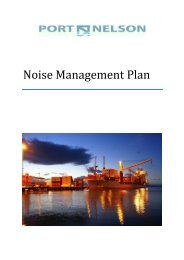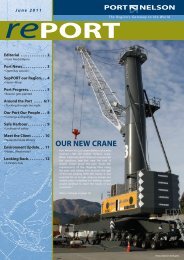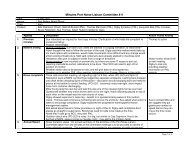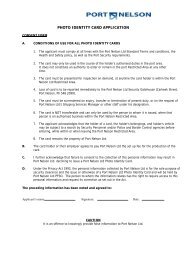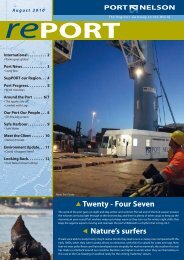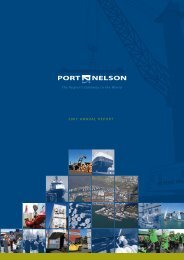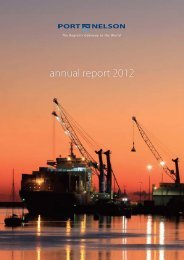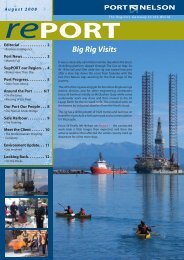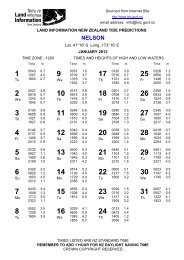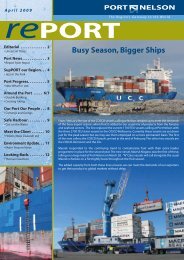December 2009 (pdf) - Port Nelson
December 2009 (pdf) - Port Nelson
December 2009 (pdf) - Port Nelson
Create successful ePaper yourself
Turn your PDF publications into a flip-book with our unique Google optimized e-Paper software.
<strong>December</strong> <strong>2009</strong><br />
rePORT<br />
Editorial . . . . . . . . . . . . . . 2<br />
• The year in review<br />
<strong>Port</strong> News . . . . . . . . . . . . . 3<br />
• New harbourmaster craft<br />
SupPORT our Region . . . 4<br />
• Best ever Masked Parade<br />
<strong>Port</strong> Progress . . . . . . . . . . 5<br />
• Given the Slip<br />
Around the <strong>Port</strong> . . . . . 6/7<br />
• Choppers land at port<br />
• Worth a thousand words<br />
Our <strong>Port</strong> Our People . . . 8<br />
• First Line Management Success<br />
Safe Harbour . . . . . . . . . . 9<br />
• Light on Haulashore<br />
Meet the Client . . . . . . . 10<br />
• Reliance Engineering<br />
Environment Update . . .11<br />
• Noise monitor installed<br />
Looking Back . . . . . . . . . 12<br />
• Boulder Bank book launched<br />
HMNzS Pukaki Makes<br />
First Ever Visit To <strong>Nelson</strong><br />
Photo: Chris Weissenborn<br />
The third of the New Zealand Navy’s new Inshore Patrol Vessels, HMNZS Pukaki, under the Command of<br />
Lieutenant John McQueen, conducted a very special first ever visit to her homeport region. Pukaki is the<br />
first naval vessel to be affiliated to the top of the south, and was greeted with a powhiri when she arrived<br />
at <strong>Port</strong> <strong>Nelson</strong> on 15 October.<br />
During the historic visit the Pukaki was involved in a Charter Parade, the ship was open to the public, and<br />
hosted tours ranging from schools to potential recruits. The Navy Band was in <strong>Nelson</strong> for the visit and led<br />
the <strong>Port</strong> <strong>Nelson</strong> Masked Parade as well as performing in a number of venues around the district.<br />
HMNZS Pukaki is a 340 tonne, 55 metre vessel with a core crew of 20. It is capable of travelling 3000<br />
nautical miles (5556 kilometres) with a top speed of 25 knots, and carries out tasks for Customs and the<br />
Ministry of Fisheries.
<strong>Port</strong> <strong>Nelson</strong> Limited report. <strong>December</strong> <strong>2009</strong>. Page 2<br />
editorial<br />
At the port company presentation to stakeholders at the end of<br />
September, Chairman Nick Patterson summed up the 2008 - <strong>2009</strong><br />
year and expressed his concerns about the impact of compliance<br />
costs on the results.<br />
<strong>Port</strong> <strong>Nelson</strong> Limited paid a dividend of $4m to its shareholders,<br />
the Tasman District and <strong>Nelson</strong> City Councils for the 2008-09 year.<br />
However, the after-tax profit would have been higher, but for the<br />
steep compliance costs the port faces in dealing with the effects of<br />
noise on port hills’ residents.<br />
The terms of the Noise Variation set by the Environment Court<br />
require us to meet the costs of full or partial noise insulation<br />
treatment for up to eleven homes near the port, and to buy the<br />
most affected homes if the owners decline mitigation treatment.<br />
This cost $1.4m over the past year and reduced the operating<br />
surplus to $4.9m after tax.<br />
Ongoing expenses we face in relation to noise mitigation work<br />
in the coming years will continue to impact on our result and<br />
the return to our shareholders. While we fully understand our<br />
obligations in this area and are committed to meeting them, the<br />
increased compliance costs that organisations such as ours have to<br />
meet are a major concern.<br />
Overall it was a satisfying result for the year with total cargo at<br />
2.755 million tonnes, boosted by log exports to China and increased<br />
imports of fuel and empty containers.<br />
The year in review<br />
<strong>Port</strong> <strong>Nelson</strong> Limited • 10 Low Street, <strong>Port</strong> <strong>Nelson</strong> • PO Box 844, <strong>Nelson</strong>, New Zealand<br />
Tel +64 3 548 2099 • Fax +64 3 546 9015 • www.portnelson.co.nz<br />
Re<strong>Port</strong> <strong>Nelson</strong> is a triennial publication produced for <strong>Port</strong> <strong>Nelson</strong> Limited by:<br />
• <strong>Nelson</strong> Media Agency - www.nelsonmedia.co.nz • SeeReed Visual Communication - www.seereed.co.nz<br />
Photography: Troy Dando, Roy Skucek, Jacquetta Bell<br />
The trend towards containerisation of processed wood products<br />
continued and the port exceeded 80,000 Twenty-foot Equivalent<br />
container Units (TEU) for the first time.<br />
The global recession reduced calls from vessels carrying motor<br />
vehicles and steel, and while there were limited changes to the liner<br />
shipping services using the port over the last 12 months we may<br />
face further changes in future.<br />
It is likely <strong>Port</strong> <strong>Nelson</strong> and most other ports will continue to see<br />
decisions made by both shipping lines and major exporters that<br />
will have an effect on shipping services around the New Zealand<br />
coast. While such changes are inevitable, they do mean we are<br />
operating in a very tight market and they make further investment<br />
in infrastructure a very uncertain science.<br />
I would like to take this opportunity to thank port customers and<br />
staff for their support throughout the year. I wish you all a safe and<br />
relaxing holiday season with time to enjoy our region in summer<br />
with friends and family.<br />
Nick Patterson<br />
Chairman, <strong>Port</strong> <strong>Nelson</strong> Ltd<br />
Briefing the Stakeholders<br />
It was a wild and wet day at the end of September when we invited 200 stakeholders to attend a briefing on our Annual Report at the <strong>Nelson</strong><br />
Yacht Club. After an introduction from Chairman Nick Patterson, Martin Byrne gave a comprehensive presentation that put the year’s result<br />
and the current port operation into a wider context of the global recession and trends in the shipping industry. Guests stayed on to enjoy<br />
refreshments and the opportunity to catch up with others in the industry.<br />
Pictured from left: PNL Chairman Nick Patterson, John McLiskie, Heartland Fruit, and Kay McNabb, <strong>Nelson</strong> Airport. Next photo: Paul Salvador and Tony Pratt from<br />
Westpac with PNL board member Bronwyn Monopoli.
Safe on the Water<br />
<strong>Nelson</strong> harbour will be a safer place this summer with the<br />
new harbourmaster boat Punawai patrolling the bay. <strong>Port</strong><br />
<strong>Nelson</strong> carries out this role for the <strong>Nelson</strong> City Council, and<br />
Marine Operations Manager Roy Skucek says the main focus<br />
is on education for boaties, backed up with infringement<br />
notices.<br />
<strong>Port</strong> <strong>Nelson</strong> Limited report. <strong>December</strong> <strong>2009</strong>. Page 3<br />
Last year the patrols were done in the pilot launch, but this year there will be a higher profile with the new boat<br />
bought from funds set aside from pilot exemption certificates. Roy Skucek says the Stabicraft was selected for the<br />
job as the most suitable. It is fitted out with VHF radios and is powered by two Mercury 150hp engines.<br />
Punawai means spring water, and was the name of the old pa site at the bottom of Richardson Street. It is estimated the Punawai will be used for<br />
up to 300 hours each year, mainly in <strong>Nelson</strong> Harbour, the Blind Channel, Monaco and up to two miles offshore. It will also support Coastguard,<br />
Police, Fire Service, NZ MAF, Customs and DOC. The Punawai will be staffed by our new deputy harbourmaster once that position is filled.<br />
Roy Skucek speaks at the naming ceremony on November 11, attended by iwi representatives, port staff, Mayor Kerry Marshall and Arch Deacon Harvey Ruru who<br />
blessed the craft.<br />
<strong>Port</strong> New zealand<br />
<strong>Port</strong> <strong>Nelson</strong> Ltd is part of a new initiative called Green <strong>Port</strong> for Black<br />
Boats, being developed to create an eco-friendly environment for<br />
servicing commercial vessels from around New Zealand and further<br />
offshore. These are ‘black boats’ in the industry, while ‘white boats’<br />
are pleasure craft. The aim is to attract boat building, research and<br />
development, aquaculture industries, water remediation and skills<br />
training for the oil and gas industry. The theme of sustainability<br />
will govern how the growth takes place and what industries can<br />
participate.<br />
We have formed a marketing consortium with selected local<br />
companies to begin building the brand around this green port<br />
initiative. This consortium is called <strong>Port</strong> New<br />
Zealand Ltd, and the initial participants are<br />
Challenge New Zealand, Kernohan Engineering,<br />
<strong>Port</strong> <strong>Nelson</strong> Ltd and Unimar. This brings<br />
together our own capabilities, such as the layup<br />
berths and the tugs, with the facilities and skills<br />
of these engineering companies.<br />
The port’s central location within New Zealand,<br />
our climate, marine and industrial services, new<br />
facilities and skilled personnel for repairs, refits,<br />
demobilisation and upgrades are part of the<br />
reason we chose <strong>Port</strong> New Zealand as the brand<br />
to market this regional initiative offshore.<br />
Management Review<br />
<strong>Port</strong> <strong>Nelson</strong> Ltd has carried out a review to ensure we have the right<br />
structure in place to meet the challenges we face in the port industry.<br />
Marine Operations has now become part of the <strong>Port</strong> Logistics team<br />
and falls under the overall responsibility of Digby Kynaston as<br />
<strong>Port</strong> Logistics Manager. This change fits firmly in line with our aim<br />
to create a port wide operational division including Stevedoring,<br />
Cargo Logistics, and Marine Operations.<br />
The other major change was the decision to re-allocate a number<br />
of key responsibilities around customer liaison and marketing.<br />
Contract negotiations with shipping lines are now handled by<br />
the <strong>Port</strong> Logistics Manager in conjunction with the<br />
CEO Martin Byrne. Business development initiatives<br />
are handled by the Chief Commercial Officer Parke<br />
Pittar, again in conjunction with the CEO. We will be<br />
appointing a Marketing Representative to service<br />
the importers and exporters of the region and to<br />
further expand our presence with someone ‘out in<br />
the field’.<br />
The executive team is now made up of Martin Byrne,<br />
CEO; Melisa Kappely, Employee Relations Manager;<br />
Digby Kynaston, <strong>Port</strong> Logistics Manager; Matt<br />
McDonald, Infrastructure Manager; and Parke Pittar,<br />
Chief Commercial Officer.<br />
port news
<strong>Port</strong> <strong>Nelson</strong> Limited report. <strong>December</strong> <strong>2009</strong>. Page 4<br />
supPORTing our region<br />
Charity Golf<br />
It was a big day out for colleagues in our industry when we<br />
played our annual <strong>Nelson</strong> <strong>Port</strong> and Transport Industry Charity Golf<br />
Tournament on November 19 at the <strong>Nelson</strong> Golf Club. There was a<br />
great turnout from shipping lines, agents, stevedores, logistics and<br />
transport sectors; some great golf was played and the 19th hole<br />
was particularly convivial! It is the second year that the <strong>Port</strong> <strong>Nelson</strong><br />
Mission to Seafarers has been the selected charity to benefit from<br />
this event.<br />
The money raised this year will go in the bank, added to the $12,000<br />
the tournament raised last year. This gives the Mission a tidy capital<br />
sum that is generating enough interest to cover everyday running<br />
costs. Manager, Milo Coldren and his team of volunteers have made<br />
the <strong>Nelson</strong> Mission one of the best in the world, with free coffee,<br />
biscuits and internet access.<br />
Over the last five years these tournaments have raised in excess of<br />
$42,000 for local charities.<br />
Darryl Hamilton takes a drive for the Hamburg Sud team, watched by Simon Edwards,<br />
Peter Anderson and Matthew Hewitt.<br />
Jazz in the Parks<br />
It’s summer and that means it’s time for the Woollaston <strong>Nelson</strong> Jazz<br />
& Blues Festival – or it will be, come the New Year. We are pleased<br />
to be backing <strong>Port</strong> <strong>Nelson</strong> Jazz & Blues in the Parks, with a regional<br />
spread from Fairfield Park to the Village Green in Takaka. Expect<br />
to see some hot acts in these concerts, with some of the foremost<br />
musicians in their fields from New Zealand, the States and the UK.<br />
In the Woods<br />
We were pleased to assist with<br />
support of the annual Forest &<br />
Wood Conference, held this year<br />
in <strong>Nelson</strong> at Seifrieds Vineyards.<br />
It was an opportunity for our<br />
staff to catch up with many<br />
of the movers and shakers in<br />
the industry from around New<br />
Zealand and even further afield.<br />
As nearly half of our total cargo<br />
tonnage is forestry product, this sector is extremely important to<br />
<strong>Port</strong> <strong>Nelson</strong> now and into the future, and it was very encouraging<br />
to see the conference reflecting increasing co-ordination across the<br />
sector in both processing and forestry.<br />
The focus was on global trends, the current trading environment<br />
and the challenges and opportunities this presents. There was also<br />
a field day of visits to <strong>Nelson</strong> forests and tours, including four buses<br />
of visitors to <strong>Port</strong> <strong>Nelson</strong>.<br />
Rags to Riches<br />
Upper Moutere’s Sunrise Cleaning Services won the <strong>Port</strong> <strong>Nelson</strong><br />
Large Business Award and the Westpac Supreme Award at this year’s<br />
Westpac <strong>Nelson</strong> Tasman Chamber of Commerce Awards. Bruce Farley<br />
and his wife Phillipa Rutherford are joint owners of Sunrise Cleaning<br />
Services and of the Chandrakirti Tibetan Buddhist Meditation Centre<br />
in Upper Moutere. Sunrise Cleaning is a rags-to-riches story, with<br />
Bruce having gone from being a one man business with his home<br />
vacuum cleaner, to employing 110 staff and servicing 80 commercial<br />
clients including many of the region's largest companies. The<br />
awards are the biggest event in the region's business calendar and<br />
provide a real incentive for<br />
business excellence from the<br />
emerging level upwards.<br />
Rod Fox and Dot Kettle from<br />
the <strong>Nelson</strong> Tasman Chamber<br />
of Commerce flank Phillipa<br />
Rutherford and Bruce Farley<br />
from Sunrise Cleaning and<br />
Digby Kynaston representing<br />
<strong>Port</strong> <strong>Nelson</strong>.<br />
Parade<br />
‘best ever’<br />
The <strong>Port</strong> <strong>Nelson</strong> Masked Parade that launched the <strong>Nelson</strong> Arts<br />
Festival in October was a triumph of creativity and optimism,<br />
forging ahead amidst wet weather into a sunny evening where<br />
<strong>Nelson</strong> was at its best – children shone, music played and<br />
people danced in the street. The parade this year was a<br />
tribute to its founder Kim Merry, who died in August. Festival<br />
creative director Annabel Norman said the parade was a<br />
fitting commemoration to Kim and the value he placed on the<br />
community celebrating together.<br />
“Thanks to the support of <strong>Port</strong> <strong>Nelson</strong> Limited, and the schools<br />
and other groups who put in so much effort it was a wonderful<br />
tribute and showed the special legacy Kim has left us: <strong>Nelson</strong><br />
has an event with a unique spirit – something money just<br />
can’t buy.” Record crowds attended the parade and stayed on<br />
afterwards to dance in the streets at the carnivale.<br />
Safety and Training Officer Jim Lane<br />
speaks to the conference delgates as they<br />
visit our timber storage and packing area.<br />
Photo: Harold Mason
Slicing Through the Mud<br />
Have you ever tried one of those fairground games where you have<br />
to land a suspended hoop onto a narrow-topped block? The problem<br />
is that the hoop is bumped sideways by the block and swings off to<br />
the side. Something similar happens when the suction bucket on the<br />
dredge Kawatiri strikes a pinnacle on the harbour floor.<br />
We are about to trial a mud slicer to deal to the pinnacle problem,<br />
that is a modified design of a similar device used at the <strong>Port</strong> of<br />
Lyttelton. The eight metre wide steel blade of the mud slicer is<br />
designed to knock off the pinnacles that are left after dredging. We<br />
will suspend it underneath the tug Huria Matenga and accurately<br />
adjust the height of the device to slice into the mud pinnacles,<br />
pushing the mud into nearby deeper water, until we achieve the<br />
desired depth.<br />
It will be used a couple of days at a time, and may only need to be<br />
called out twice a year after dredging.<br />
Paving the Way<br />
We have just embarked on strengthening and resurfacing 5,100sq<br />
metres of the Container Yard, near Shed #3. The is the fourth year we<br />
have tackled this staged upgrade, giving us a durable surface for heavy<br />
duty machinery. The half million dollar project involves digging down<br />
to 600mm, replacing the excavated material mixed with cement, and<br />
resurfacing with a polymer modified flexible asphalt.<br />
Given the Slip<br />
<strong>Port</strong> <strong>Nelson</strong> Limited report. <strong>December</strong> <strong>2009</strong>. Page 5<br />
Our two tugs WH Parr and Huria Matenga were put on the slip in September for their survey inspection and Safe Ship Management Certificate<br />
renewal. The weather behaved while staff and contractors spent several feverish days blasting, painting and carrying out repairs on both<br />
vessels. The tugs’ hulls were cleaned and painted, their propellers were removed so they could be cleaned and balanced, various other work<br />
was done, then there was an inspection that covered everything from fire fighting equipment to navigation<br />
lights. The two tugs were slipped one at a time and Centre <strong>Port</strong>’s tug Ngahue came over from Wellington<br />
to cover our shipping work.<br />
▲<br />
While our tugs have propellers at the back, the Ngahue pulls from the stern, with<br />
all the manoeuvres in reverse, in a system called indirect towing.<br />
No Luffing Matter<br />
A head for heights was<br />
needed by the team from<br />
our workshop when they<br />
tackled the task of replacing<br />
the luffing cylinder on one<br />
of the Liebherr cranes. There<br />
had been some concern from<br />
the Austrian suppliers about<br />
the integrity of this part, and<br />
several have been replaced<br />
around the world. The luffing<br />
cylinder is the hydraulic arm<br />
that picks up the boom. It<br />
weighs six tonnes, and is 20 metres off the ground. The trickiest part<br />
of the job was getting the old hinge pin out, which was achieved by<br />
lancing it with gas to melt the steel then pressing the pin out. It was<br />
a six day job, but the new cylinder went in without a hitch and the<br />
crane was ready for action before the next ship arrived.<br />
port progress
<strong>Port</strong> <strong>Nelson</strong> Limited report. <strong>December</strong> <strong>2009</strong>. Page 6<br />
around the port...<br />
Disaster Recovery<br />
If we had a fire in our server room, a leaky pipe or a malicious break-in, our<br />
business would grind to a halt and our ICT systems could be out of action for<br />
weeks. To avoid this we now have an offsite Disaster Recovery Centre, where<br />
core applications such as email and the operating application, Jade, will<br />
have a near-live copy running at the Gen-i office in Waimea Road to keep us<br />
operational. Senior Business Analyst Hugh Stark says if a disaster happened<br />
the wireless network switches would interrupt the current network and<br />
re-point everything up to Gen-i, where a copy of our server can be running<br />
within seconds. The plan is to add the other major systems that cover payroll,<br />
financials and so on to the server at the Disaster Recovery Centre.<br />
Hugh Stark and Gen-I Senior Systems Engineer Carl Snelgrove with the <strong>Port</strong> <strong>Nelson</strong> server<br />
in Gen-i’s windowless, double-skin concrete Disaster Recovery Centre. The silver box is the<br />
new server, while the black box above it is the tape copy system.<br />
Photo: Mark Harrison and Jaimie Baird<br />
More Naval Action<br />
HMNZS Manawanui visited <strong>Port</strong> <strong>Nelson</strong> in September after completing navigation training in<br />
the Marlborough Sounds. The training was part of the ship’s build up towards Electronic Chart<br />
Accreditation. Manawanui arrived in <strong>Nelson</strong> via French Pass, a first for many onboard including<br />
the Lieutenant Commander Phil Rowe, who says there was some tight timing involved.<br />
“French Pass is infamous throughout New Zealand and can be a treacherous piece of<br />
water with tidal streams of up to 8 knots, timing is crucial and there is only a 10-15 minute<br />
window to pass through,” he said. “Everyone, including myself was on tenterhooks but our<br />
planning paid off and we transited with ease.”<br />
During the visit to <strong>Nelson</strong> Manawanui hosted a visit from the local Sea Cadet Unit, TS<br />
Talisman. Fourteen cadets visited the ship and were given a tour and afternoon tea.<br />
Chopper Landing<br />
Helicopters usually land from the air – but in early November six Sea Sprites landed at <strong>Port</strong> <strong>Nelson</strong> from the Tasman Chief. The older style<br />
choppers were quickly lifted for a road trip to Woodbourne Air Base, where they will be used for ground crew training. They had been<br />
customs cleared in Auckland, but had a brief MAF inspection in <strong>Nelson</strong> just like any other used vehicle, and will be fully cleared by MAF once<br />
they are unwrapped in Blenheim. The unloading involved Smith Cranes and DHL who handled the logistics.
Worth a Thousand Words<br />
Cap Capricorn in the Cut<br />
The Cap Capricorn made her first entrance through the Cut, back in<br />
mid-August. She is now a regular caller as the shipping line Hamburg<br />
Sud’s contribution to the North Asia Vessel Sharing Agreement that<br />
replaced the COSCO service to <strong>Nelson</strong>. The other vessels on this<br />
service are NYK line’s ACX Diamond and MOL’s JPO Leo. These are<br />
all in excess of 220m and are among the largest ships calling at<br />
<strong>Port</strong> <strong>Nelson</strong>.<br />
Major Jade upgrade<br />
We expect to save an hour and half every day in staff time with<br />
our move to the latest Jade cargo control software. Currently<br />
three moves have to be logged in for a container that comes into<br />
the port full, comes back empty and is refilled. The new system<br />
reduces this to just one event and saves a lot of data entry time.<br />
<strong>Port</strong> <strong>Nelson</strong> Limited report. <strong>December</strong> <strong>2009</strong>. Page 7<br />
They’re energised<br />
Nick is third from right, facing the camera<br />
with both thumbs up.<br />
Every picture tells a story and this one more<br />
than most. The young girls are in rowing club<br />
chase boats, and had been doing their usual<br />
practice when they found a stranded dusky<br />
dolphin on the sand bar near the Boulder Bank<br />
baches. The Tasman District Council Harbourmaster<br />
called <strong>Port</strong> <strong>Nelson</strong> and the pilot boat<br />
was used to take DOC staff out to assist. The<br />
ranger with the rifle is explaining to the girls<br />
that it was too late to save the dolphin.<br />
A cold, wet tent shared<br />
with nine others, early<br />
morning PT and a<br />
swim in the Sounds did<br />
nothing to deter the<br />
latest staff members we<br />
sent on the Outward<br />
Bound eight day<br />
Navigators’ Course.<br />
Stevedore Nick Brinsley<br />
says if he saw the details<br />
in a holiday brochure,<br />
he wouldn’t book the<br />
holiday, but he came<br />
back fully energised.<br />
“Rather than just having my batteries recharged it was more like<br />
a new set of much higher tech batteries,” he says. “I also returned<br />
feeling wiser and richer and I have some new goals to focus on.”<br />
A few weeks later Hayden Grainger from Cargo Operations was off<br />
on the same course. He says he was surprised to find fitness was not<br />
the challenge – it was more the intense personal development.<br />
“In the group situation and as an individual they really challenge<br />
you,” he says. “I think<br />
I came out of it with a<br />
much better understanding<br />
of myself and<br />
a better understanding<br />
of other people and the<br />
differences we all have.”<br />
Every year we send two<br />
staff members to attend<br />
this course, which focuses<br />
on the core skills to lead a<br />
team effectively.<br />
...and beyond
our port our people<br />
Study Success<br />
Going ‘back to school’ may have been a little daunting at first, but<br />
QuayPack Supervisor Andy Farmer and Security Gate Operator<br />
Kamelia Chapman did well and finished up pleased with the outcome<br />
of their nine month course of study at NMIT for the National<br />
Certificate in First Line Management. Most of the study for the nine<br />
modules was done online, and topics ranged from business writing<br />
to time management.<br />
Kamelia says she found the time management skills useful in fitting<br />
in her work on the course: “Writing things down and planning ahead<br />
were also useful recently to get everything done when I stood in for<br />
Security Supervisor Bill Homan while he was overseas.”<br />
Andy says the team building and conflict resolution skills have<br />
already come in handy: “It’s good to nip any conflict in the bud –<br />
turning a blind eye certainly won’t help it to get any better,” he says.<br />
Andy and Kamelia are both keen to take their study further.<br />
QuayPack<br />
Goes Calling<br />
When you spend your days<br />
packing MDF into containers<br />
it’s nice to know where it came<br />
from. To give the QuayPack<br />
team more ‘product knowledge’,<br />
<strong>Nelson</strong> Pine Industries Despatch<br />
Manager Warran Clark ran a site<br />
tour for them in November.<br />
QuayPack Supervisor Andy<br />
Farmer says it’s the second<br />
time his team have visited NPIL.<br />
The last time was a couple of<br />
years ago, and the recent trip<br />
was for new players on the port<br />
container packing team.<br />
<strong>Port</strong> <strong>Nelson</strong> Limited report. <strong>December</strong> <strong>2009</strong>. Page 8<br />
Staff Briefs<br />
• In July we marked the end of an era with a farewell morning<br />
tea for Tony Graham and Neville Clark who have held the<br />
watchman-security role since the days the <strong>Port</strong> <strong>Nelson</strong> flag was<br />
raised at the start of each working day.<br />
• Congratulations and best wishes to Tina Rajino on her marriage<br />
to Andrew Maxwell in late July. Tina and Andrew tied the knot<br />
in Fiji and to celebrate staff enjoyed a girl’s night out at The Free<br />
House prior to Tina’s big day.<br />
• Marine Operations Manager and Harbourmaster Roy Skucek<br />
will be leaving us in January. Roy took over from long-serving<br />
Harbourmaster Captain John Westbrooke in 2006 and says<br />
while his three years with PNL have been challenging, it has also<br />
been interesting being involved in changes at the port.<br />
• We farewelled Chris Williams at the end of September. Chris had<br />
been with us as Marketing Manager since 2004 and worked<br />
hard to maintain shipping options for our clients in times of<br />
major change from the lines servicing regional ports.<br />
Silver for Les<br />
Les Gill from Cargo Operations is the latest staff member to join<br />
that exclusive club of staff who have worked at the port for 25<br />
years or more. Les grew up in Invercargill, moving to <strong>Nelson</strong> in<br />
1982 and soon after got a job on the suction dredge Karatea,<br />
as the Maitai reclamation took shape. Next, Les took on the role<br />
of caring for the newly created land, laying lawns and planting<br />
shrubs around Akersten Street and the Marina back in the days<br />
when the Harbour Board was in control of this area.<br />
Les has had a hand in many milestones at the port, such as packing<br />
the first MDF in containers, laying the groundwork for what is<br />
now QuayPack. He recalls a time when he and Phil Francois were<br />
the only staff at the Container Yard and all the documentation<br />
was done by hand – before the advent of computers.<br />
For the last five years Les has run our Quarantine Facility,<br />
devanning hi-risk containers and calling in the MAF team if he<br />
finds contamination or wildlife! Les takes the responsibility of this<br />
job seriously and looks back at a working life that has provided<br />
him with an income, stability and the company of a ‘good<br />
bunch of guys’.<br />
Les brings the total number of ‘silver servers’ to 13 - the longevity<br />
of service in our team is testimony to staff commitment and the<br />
enjoyment our people take in their work.
Health Checks<br />
Sitting all day in a forklift can be hard on your<br />
back, but our drivers now have a range of tips<br />
to avoid pain associated with long sits. Earlier<br />
in the year Nikola Huntingford, an Occupational<br />
Therapist with Ramazzini, carried out ergonomic<br />
assessments focussed on maximising operator<br />
comfort, efficiency, safety and ease of use.<br />
Drivers were wised up on the importance of<br />
micropauses, muscle stretches, and improved<br />
positioning of head, neck, trunk and limbs.<br />
Chris Growcott took the tips on short breaks and<br />
stretching exercises to heart, and keeps the info in the<br />
cab of his hi-stacker as a reminder.<br />
Coastguard to<br />
the Rescue<br />
We were pleased to provide the<br />
Coastguard Service with a safe area to<br />
train boat operators and to offer the<br />
help of our training officer Jim Lane in<br />
the pilot vessel.<br />
The day was a great success, with 12<br />
students passing the course. Those<br />
involved felt it was worthwhile, and<br />
the class is likely to be repeated for<br />
Coastguard and for Sea Scouts.<br />
Coordinator Milo Coldren says it’s<br />
encouraging to see the emphasis on<br />
training to improve safety for youth.<br />
Keeping Safe<br />
<strong>Port</strong> <strong>Nelson</strong> Limited report. <strong>December</strong> <strong>2009</strong>. Page 9<br />
Light on Haulashore<br />
▲<br />
Handling the Lines<br />
This graphic representation indicates<br />
where the light will be placed. It will be<br />
ten metres above ground and the pole<br />
will be made of wood, to better blend<br />
with the environment. The route of the<br />
cable is indicated in yellow, but it will be<br />
trenched to low water mark.<br />
It’s not exactly traffic lights, but it will tell boaties when they need to stay clear of the Cut. We are in resource consent stage prior to installing<br />
a ‘stop-go’ light on Haulashore Island. This is part of the harbourmaster’s response to the recommendation in the port’s navigational risk<br />
assessment for ‘greater attention to the management of recreational activity and conflicts between commercial and recreational craft’. The<br />
light will be seen from a pole, to be erected on the northern side of Haulashore Island and will flash red when a large vessel movement is<br />
imminent and then turn to fixed red to indicate the Cut is closed to all craft other than the large vessel and assisting tugs. After consultation<br />
with iwi and environmental groups it was decided rather than digging the cable in across Haulashore, it would be run on the seabed from<br />
Wakefield Quay.<br />
Eight new line handlers joined our Marine Services at the end of July. Initial training<br />
covered all aspects of hazard identification and safety procedures around line handling,<br />
the practical side of the job and the context of wider port operations. The line handlers<br />
have now been on the job for four months and are confident in their work.<br />
We welcome any suggestions or information to make <strong>Port</strong> <strong>Nelson</strong> a safer working environment.<br />
If you have a name you would like added to our mailing list, please let us know.<br />
From left are<br />
Pat Bevernage,<br />
Rutene Cooper,<br />
Glen Bisdee,<br />
Andrew Rankin,<br />
Alan Baumgart,<br />
Bob Huggins,<br />
Jim Tompkins<br />
and Neil<br />
McArtney.<br />
safe harbour
<strong>Port</strong> <strong>Nelson</strong> Limited report. <strong>December</strong> <strong>2009</strong>. Page 10<br />
connections<br />
A company we RELY on<br />
“The fundamentals at Reliance are very good with a strong team-based culture that is a credit to the effort<br />
put in over the years from guys like our Works Manager Kim Harris,” Andrew Gray, General Manager says.<br />
“We are a very traditional family-type engineering business with a number of loyal and long standing<br />
customer relationships, good skills and quality, and strong business ethics.”<br />
Reliance Engineering’s connection with <strong>Port</strong> <strong>Nelson</strong> Limited goes back<br />
many years. Right now, under a new ‘helmsman’, Reliance is looking to<br />
build on the strong relationship between the two companies as it<br />
begins to unfold some meaty growth plans for the future.<br />
Andrew Gray and Kim Harris with the<br />
new mud slicer, under construction in<br />
the Reliance workshop.<br />
The business was acquired last year by the Challenge New Zealand<br />
Group, which has three other port based companies under its<br />
umbrella: Fluid Power Solutions, Challenge Marine, and McBride<br />
Design. The four businesses work independently in various sectors<br />
of engineering (land based, marine, hydraulics and design), each with<br />
its own management team responsible for the strategic direction of<br />
their business unit.<br />
Andrew Gray was appointed as General Manager for Reliance earlier<br />
this year. He has lived in <strong>Nelson</strong> for five years, contracting to the Pike<br />
River Coal scheme on the West Coast for the past three years.<br />
Andrew says he came into a company where the existing management<br />
team had created a sound platform, and the last six months have<br />
seen a lot of intensive planning and work on strategies for growing<br />
the business over the next 10 to 15 years.<br />
The North Cardinal<br />
Beakon was fabricated for<br />
<strong>Port</strong> <strong>Nelson</strong> by Reliance<br />
Engineering in 2006.<br />
Andrew rates the port company as an ‘A-Class’ client, and says<br />
Reliance staff work closely with the port infrastructure team and<br />
have developed a high level of trust. There are not many weeks<br />
where Reliance has not got a project on the go for <strong>Port</strong> <strong>Nelson</strong> – they<br />
recently constructed a mud slicer that will be suspended under the<br />
tug Huria Matenga to take pinnacles of material off the sea floor in<br />
the shipping channels. (Read more in <strong>Port</strong> Progress on page 5.)<br />
The future looks bright for Reliance: “We are very excited about the<br />
next few years, this year we are working hard on priming the business<br />
for the future, bedding down our plan and aligning that with Group<br />
objectives,” Andrew says. “We are making sure our management<br />
systems are robust, and building on our capacity and capabilities.”<br />
Andrew says the strong relationship with <strong>Port</strong> <strong>Nelson</strong> will be<br />
increasingly important in the future, as the port is a critical part of the<br />
company’s growth plan to attract new engineering opportunities to<br />
the region and access potential markets throughout New Zealand<br />
and overseas.
<strong>Port</strong> <strong>Nelson</strong> Limited report. <strong>December</strong> <strong>2009</strong>. Page 11<br />
Fighting Marine Pests<br />
▲<br />
The potential for pest species to harm the unique marine<br />
environment of the top of the South Island is being minimised<br />
through the work of a new partnership between central and<br />
local government, the eight Iwi of the area, community and<br />
industry interests. This collaboration, the Top of the South<br />
Marine Biosecurity Partnership, was launched in <strong>Nelson</strong><br />
in September and is a pilot programme funded by MAF<br />
Biosecurity New Zealand and local councils. They’ve contracted<br />
Mincher Campbell Limited to tackle coordination and advocacy.<br />
Coordinator Russ Mincher says the first job is to identify the<br />
high-value areas to protect, develop surveillance programmes<br />
to look out for new marine pests and begin to identify activities<br />
that pose a risk of spreading marine pests. Russ says it’s vital<br />
local boat owners keep the hulls of moored boats clean and<br />
well anti-fouled. And boaties are asked to report anything unusual<br />
they see out there to MAF’s pest and disease hotline: 0800 80 99 66.<br />
New dredging consent<br />
The Kawatiri was in <strong>Nelson</strong> to do our annual maintenance dredging<br />
in October, the first visit since we obtained our new consents, which<br />
requires considerably more sampling and testing than in the past.<br />
The new consents for dredging and disposal of spoil are for a period<br />
of 30 years, giving us much more certainty on maintaining the<br />
navigation channels to their required depth.<br />
The tests included hopper sediment sampling from three areas<br />
inside and outside the Cut, which was done by the dredge crew,<br />
using sampling containers supplied by Cawthron with the material<br />
then tested at the Cawthron laboratory.<br />
Cawthron scientists (photo below) also went out to the spoil disposal<br />
ground in their boat and followed the discharge plume after the<br />
dredge had disposed<br />
of a hopper load. They<br />
ran tests for particles,<br />
smell and appearance<br />
of the water quality.<br />
Cawthron also tested<br />
sediment samples from<br />
within the dredging<br />
areas.<br />
Stepping to Awareness<br />
The old Indian saying about walking in someone else’s moccasins holds<br />
true for crane drivers – it’s hard to fathom just what their job entails,<br />
without seeing them in action. The <strong>Port</strong> Noise Liaison Committee was<br />
offered this opportunity after their September meeting, when they<br />
made a trip to Main Wharf South and climbed up to the crane cabin<br />
to see what’s involved in trying to land a container quietly – when you<br />
can’t always see it or the space it’s to go in, when the wind is blowing<br />
and when you are dependent on a guy with an RT in the ship’s hold<br />
acting as your eyes and ears. The members of the committee got a new<br />
understanding of what it takes to make container handling a quiet<br />
operation, the skills of the drivers and the rest of the stevedoring crew,<br />
and the lengths they take to keep the operation as quiet as possible.<br />
Noise committee chairman Bob Dickinson and residents’ rep Bruce Robinson at the<br />
top of the crane.<br />
A diver filming during a survey of<br />
‘wildlife’ on port piles.<br />
letters to homeowners<br />
and have about 35 who<br />
have requested more<br />
information, and some<br />
have requested further<br />
mitigation work.<br />
The feedback from<br />
residents’ reps on<br />
the Noise Liaison<br />
Committee is very<br />
positive about the<br />
process we are working<br />
through. We now have<br />
a continuous noise<br />
monitor up and running<br />
to provide us with<br />
valuable information<br />
about how much noise<br />
Noise update<br />
We are making progress on meeting the<br />
terms of the Noise Variation adopted<br />
by the <strong>Nelson</strong> City Council last year,<br />
and working with residents on the full<br />
or partial noise insulation treatment<br />
for homes near the port. To date we<br />
have bought three of the most affected<br />
homes where the owners elected to sell.<br />
These homes have now been treated<br />
to mitigate noise and two have resold.<br />
There has been progress on noise<br />
treatment now with 8 out of the 11<br />
most affected homes. In the next tier, of<br />
less affected homes, we have sent 110<br />
Workshop Supervisor Craig Terris with<br />
the new noise monitor that has just been<br />
installed on the cement silo.<br />
we are actually making, with the hope being that this will allow us to<br />
more effectively manage noise at source.<br />
Re<strong>Port</strong> is Green<br />
In line with our environmental policies<br />
Re<strong>Port</strong> uses elemental chlorine free paper<br />
produced from sustainably managed forests.<br />
Re<strong>Port</strong> is printed with vegetable based inks.<br />
environment update
<strong>Port</strong> <strong>Nelson</strong> Limited report. <strong>December</strong> <strong>2009</strong>. Page 12<br />
looking back<br />
Rolling Stones on the Boulder Bank<br />
From its place in Maori myth to the ongoing debate about how the bank was formed, local<br />
writer Karen Warren has captured the many facets of the Boulder Bank in a new book with<br />
the catchy title Rolling Stones - <strong>Nelson</strong>'s Boulder Bank, Its Place in our History and Hearts.<br />
Photo:<br />
<strong>Nelson</strong> Provincial Museum,<br />
Copy Collection, C182.<br />
Karen reveals that our Boulder Bank is the largest of any such<br />
naturally occurring landform in the world; it is longer than England’s<br />
Chesil Beach and the Amanohashidate that spans Miyazu Bay in our<br />
Japanese sister city.<br />
Karen says the book, her first, grew out of her own fascination with<br />
the Boulder Bank.<br />
“For those of us who live in <strong>Nelson</strong> it is easy to take its embrace for<br />
granted, content in the sheltering protection it gives as we enjoy<br />
the marine playground of <strong>Nelson</strong> Haven,” she says. “In this book<br />
I have set out to provide a broad picture of the physical nature<br />
and characteristics of the Boulder Bank, the impact of Maori and<br />
European settlers, and how the Boulder Bank itself has influenced<br />
our history.”<br />
Boulder Bank Bill<br />
The story of Boulder Bank Bill is one of many tales documented in<br />
Rolling Stones. Bill Clark was a retired Scottish seaman who became<br />
known as Boulder Bank Bill. Karen quotes from a feature on Boulder<br />
Bank Bill printed in the <strong>Nelson</strong> Evening Mail in 1994, when he was 83<br />
years old and had lived on the Bank for 37 or 38 years. He bought his<br />
bach for £35, but had never intended to stay on the Boulder Bank:<br />
“It was to be a refuge … But as I got older I got lazier and everything<br />
got easier. I would not go back to town now… When I first arrived<br />
this place was a terrible shack. An open fire with water running down<br />
walls made from all sorts of rubbish. I’ve got a world of my own here<br />
The stories of the people who lived on the<br />
Boulder Bank include the keepers of the<br />
lighthouse, documented in Karen Warren’s new<br />
book, Rolling Stones.<br />
– sometimes too much so. But it’s a home. In a house all you want is<br />
comfort, convenience, warmth, food, and a good bed.<br />
“Some people are afraid of high seas covering us, but it doesn’t worry<br />
me. The Bank goes down a long, long way. In any case, it’s warmer<br />
here in winter with no frosts. That’s something I notice when I go over<br />
to <strong>Nelson</strong>. It’s really cold sometimes. The sea makes things warmer.”<br />
It was not a luxurious life by any means. There was no electricity and<br />
the freshwater supply was from water off the roof. The Mail noted:<br />
“His hardboard floors are bare, his bed built of strips of wood nailed<br />
together and fixed to the wall in the corner of the bedroom.”<br />
Bill recalled how, when he was younger, overseas ships used to throw<br />
their dunnage overboard. This provided him with a ready supply of<br />
wood for his fireplace but the practice later died out. He typically<br />
had large stacks of chopped driftwood piled outside his home.<br />
For many years he regularly rowed ashore to buy his supplies and<br />
socialise. He kept an old bike at the port to use as transport and<br />
he would cycle around to collect his groceries, source new library<br />
books, visit the RSA and carry out any other errands. He later got an<br />
outboard motor for his dinghy to make life a little easier.<br />
Rolling Stones – <strong>Nelson</strong>’s Boulder Bank has full colour illustrations<br />
throughout its 320 pages. There are many historic photos, and<br />
contemporary shots by Karen’s husband, John Warren. The book is<br />
published by Nikau Press and is available at <strong>Nelson</strong> bookstores for<br />
$75. For more info contact the publisher nikau@ts.co.nz.



